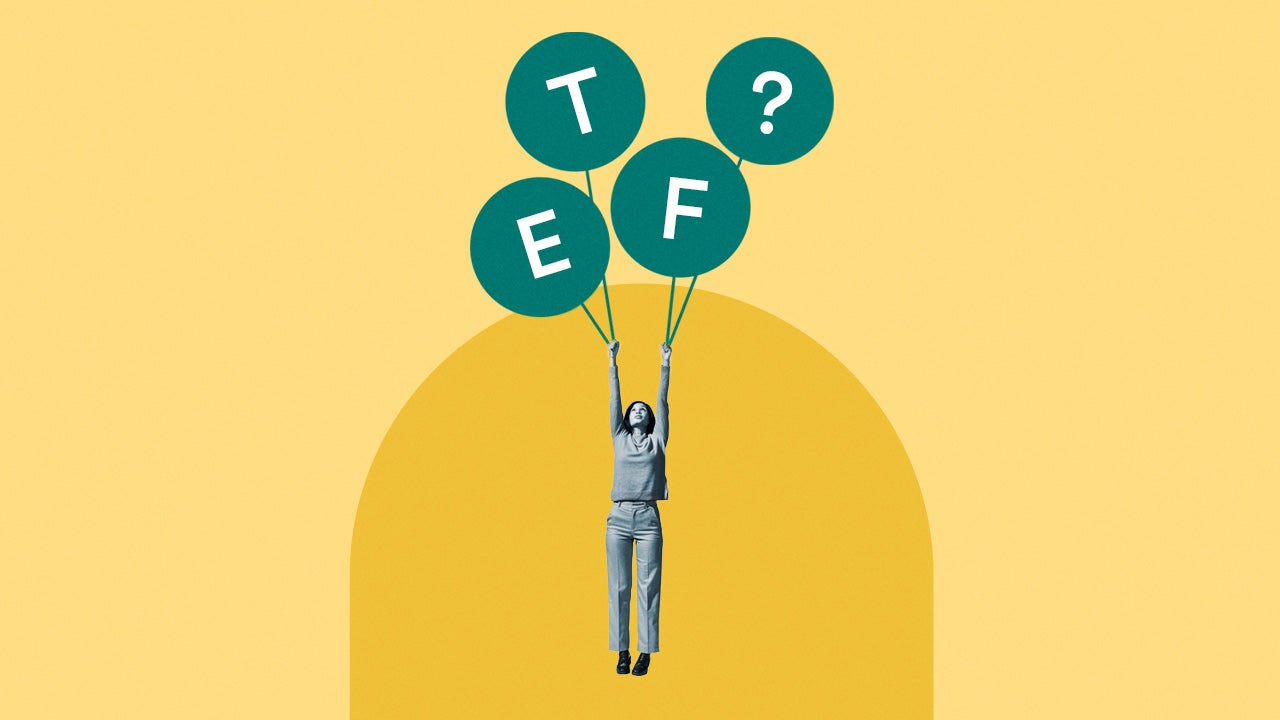Exchange-traded funds, or ETFs, are one of the hottest investing trends of the last two decades. ETFs held about $11 trillion in assets at year-end 2023, according to research conducted by TrackInsight in collaboration with J.P. Morgan, reaching historic highs for the fast-growing asset class. ETFs allow investors to buy a collection of assets in just one fund, and they trade on an exchange like a stock. They’re popular because they meet the needs of investors, and usually for low cost.
Here’s what you need to know about ETFs and why so many investors are drawn to them.
What is an ETF and how does it work?
ETFs are a type of fund that owns various kinds of securities, often of one type. For example, a stock ETF holds stocks, while a bond ETF holds bonds. One share of the ETF gives buyers ownership of all the stocks or bonds in the fund. For example, if an ETF held 100 stocks, then those who owned the fund would own a stake — a very tiny one — in each of those 100 stocks.
ETFs are typically passively managed, meaning that the fund usually holds a fixed number of securities based on a specific preset index of investments. In contrast, many mutual funds are actively managed, with professional investors trying to select the investments that will rise and fall.
For example, the Standard & Poor’s 500 index is perhaps the world’s best-known index, and it forms the basis of many ETFs. Other popular indexes include the Dow Jones Industrial Average and the Nasdaq Composite index. ETFs based on these funds — they’re called index funds — just buy and hold whatever is in the index and make no active trading decisions.
ETFs trade on a stock exchange during the day, unlike mutual funds that trade only after the market closes. With an ETF, you can place a trade whenever the market is open and know exactly the price you’re paying for the fund.
For these benefits, ETFs charge an expense ratio, which is the fee paid by investors for managing the fund. The advent of ETFs has caused the expense ratios of both mutual funds and ETFs to fall drastically over time, as cheap passively managed ETFs became popular.
What are the major types of ETFs?
ETFs come in a variety of flavors that cater to the needs of investors. ETFs chop up the market into industries, investment themes, valuation and other characteristics that investors care about.
Here are some of the most popular ETF categories and what they include.
- Value stocks
-
Stocks that look cheap relative to their earnings or assets. Value ETFs are the funds that hold these stocks.
- Industry
-
Securities from companies in a specific industry, such as consumer goods.
- Major indexes
-
Stocks based on a major index such as the S&P 500 or the Nasdaq 100.
- Country
-
Stocks with substantial exposure to a given country.
- Company size
-
Own companies of a given size, typically either small, medium or large.
- Bonds
-
Bonds sliced by any number of characteristics, including safety, duration and issuer.
- Commodity
-
Investments in physical commodities (gold, for example) or producers of it.
- Inverse
-
Inverse ETFs go up when the price of the holdings go down, allowing investors to profit on the decline of securities.
Fund managers can dissect the market into almost any number of characteristics if they think investors will be interested in buying the end product.
Pros and cons of ETFs
ETFs offer a number of important advantages to investors, especially in terms of investment choice, ease, and expense. But ETFs are also valuable because they allow investors to “slice and dice” the investing universe and gain exposure to specific investing “themes.”
Pros
- Investment choice: ETFs give investors new investment choices, because they create new securities as funds. With an ETF, you can invest in an S&P 500 index fund right on the exchange, rather than having to buy a small piece of each stock.
- Diversification: ETFs allow investors to easily achieve objectives such as diversification. One fund can provide instant diversification, either across an industry or across the entire market. Investors can easily buy multiple funds that target each sector they’d like to own.
- Low cost: ETFs can be relatively cheap as well, and they’ve only gotten cheaper over time. The asset-weighted average expense ratio of a stock index ETF was 0.14 percent in 2024, according to the Investment Company Institute, and the number has been falling for the last decade. It was even cheaper for bond index ETFs, with an expense ratio of just 0.10 percent. The best index funds, such as those based on the S&P 500, go for much cheaper than that even. The Vanguard S&P 500 ETF (VOO), for example, costs 0.03 percent.
- Focused investments: ETFs are also popular because they allow investors to create exposure to specific sectors or investing themes. For example, ETFs can focus on high-yield stocks or value-priced stocks. They can target biotech stocks or companies with exposure to Brazil or India, for example.
- More tax-efficient: ETFs are structured so that they make only minimal distributions of capital gains, keeping tax liabilities lower for investors.
Cons of ETFs
- Can be overvalued: ETFs can trade at a higher net asset value than their individual holdings. That is, investors may be able to pay more for the ETF than it actually owns. That said, this situation doesn’t happen often and the spread is rarely wide, but it can happen. In contrast, mutual funds always trade at their net asset value.
- Not as focused as advertised: ETFs do not always offer the level of targeted exposure that they claim to. For example, some ETFs provide exposure to certain countries, and they’ll own companies based in that area. The issue is that often the large companies that comprise much of the fund earn a large portion of their sales from outside the targeted area. For instance, imagine an ETF that gives focused exposure to England, and to do so it owns, among many other companies, a stake in a British-based company such as Diageo, a maker of spirits. But Diageo also earns a huge percentage of its sales from outside the country. So an ETF can be much less focused on a specific niche than you would believe, given the fund’s name and purported target. So you often have to look into a fund’s holdings to understand what you actually own.
ETFs vs. mutual funds
While mutual funds and ETFs have similar goals to own a wide variety of assets in one security, they have many key differences, and those differences have helped ETFs thrive, especially in the last decade. Here are some of the main areas where these two kinds of funds differ.
| Category | Mutual fund | ETF |
|---|---|---|
| Average annual expense (2024)* | 0.64 percent for actively managed stock funds; 0.47 for active bond funds; stock and bond index funds average 0.05 percent | 0.14 percent asset-weighted average for stock funds; 0.10 percent for bond funds |
| Commission | May run as high as $50 at major brokers, though many brokers offer free trades on select funds | Free at major online brokers |
| Initial minimum | Often a few thousand dollars unless purchased as part of a 401(k) or other retirement plan | Usually just the cost of a single share, sometimes just $10 or $20, depending on the fund |
| Management style | Active and passive | Mainly passive |
| When does it trade? | After the market closes | When the exchange is open |
| Investment strategies | All kinds, value stocks, dividend stocks, bonds, indexes, etc. | All kinds, value stocks, dividend stocks, bonds, indexes, etc. |
| *According to the Investment Company Institute |
The passive strategy used primarily by ETFs keeps management fees low, and this low cost is passed on to consumers in the form of low expense ratios. Over time, that’s put pressure on the expense ratios of mutual funds to come down in order to compete.
ETFs vs. stocks
While ETFs and stocks both trade throughout the day, there are some key differences between the two types of securities.
A stock represents an ownership interest in a single company while an ETF holds a number of different stocks or other assets. A stock ETF may hold stock in hundreds of different companies, allowing its investors to hold a diversified portfolio by owning just one security: the ETF.
That diversification reduces the risk for investors, compared to holding a single stock or just a few individual stocks. An ETF is generally less volatile than an individual stock, as well.
Are ETFs good for beginners?
ETFs are popular because they offer investors a lot of valuable traits. And that’s especially good for beginning investors.
- Low minimum investment: The minimums for ETFs are usually the cost of just one share, which can vary from very little to perhaps a couple hundred dollars. Compare that with the minimum initial investment for a mutual fund, which might run into the thousands. And some brokers will even allow you to buy fractions of shares, so you don’t even need enough for a full share to get started.
- Usually commission-free: On top of that, many brokers allow you to trade ETFs without a commission. Charles Schwab and Fidelity are notable examples, but Robinhood also offers all the ETFs on its platform without a trading fee. So you can get in the game at a very low cost.
- Thematic: ETFs also allow investors to buy into a specific investing theme easily, even if they don’t know much about it. If you’re not a biotech expert, a focused biotech ETF will give you exposure to the industry, so you don’t have to pick and choose which companies are the winners.
- Diversification: ETFs also offer instant diversification. You can buy one fund and own a specific set of companies that are focused on one area of the market, or even own the whole market. In either case, you get diversification and the risk reduction that comes with it.
- Own the market: Finally, ETFs also allow you to buy popular indexes such as the S&P 500, letting you “own the market” and get the market return, which has averaged about 10 percent annually over time. It’s incredibly easy for investors to buy such an ETF and enjoy the market average with little investing work.
Here are some top ETFs to consider this year.
Are ETFs a good investment?
How an ETF performs depends entirely on the stocks, bonds and other assets that it’s invested in. If the fund’s investments rise, then the ETF will rise as well. If its investments fall in value, the ETF’s price will fall, too. In short, the performance of the ETF is just a weighted average of all its holdings. So not all ETFs are created equal, and it’s important to know what your ETF is invested in.
But the structure of an ETF is a good setup for investors, largely due to their low costs.
ETFs tend to have low expense ratios — the cheapest funds cost just a few dollars annually for each $10,000 invested. In large part, that’s because they’re passive investments, meaning that they use preset indexes to determine what they own, rather than paying high-priced investment managers to actively scour the market for the best holdings. The goal of a passive ETF is to track the performance of the index that it follows, not beat it.
In addition, ETFs also give you all the benefits listed above: low investment minimums, diversification, a focused or thematic investment and a wide choice of funds.
Bottom line
ETFs have proven incredibly popular in the last few decades, and that popularity is set to continue. One of the most popular investing strategies — buying and holding an S&P 500 index fund — has been recommended by legendary investor Warren Buffett. While the influx of cash to ETFs might hiccup when the market fluctuates, the long-term trend toward ETF investing looks clear.
Editorial Disclaimer: All investors are advised to conduct their own independent research into investment strategies before making an investment decision. In addition, investors are advised that past investment product performance is no guarantee of future price appreciation.
Read the full article here
















